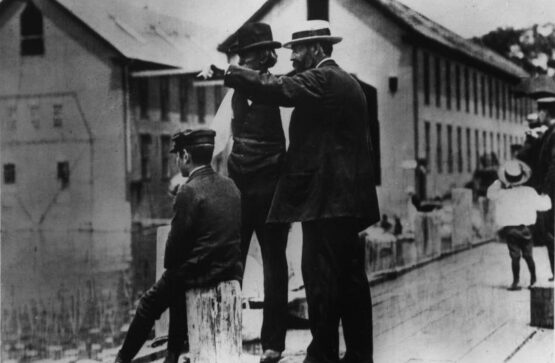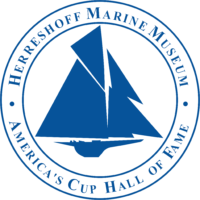June 25, 2020
Curator’s Log: Captain Nat and the Herreshoff Biographies
Part Four: About Nat Himself by John Palmieri

Part Four: About Nat Himself
By John Palmieri
Introduction
In 1926 Captain Nat Herreshoff (1848-1938) was provided six Herreshoff biographies from the 1904 volume of The National Cyclopedia of American Biography. This is the fourth of a multi-part series on Capt. Nat’s subsequent efforts, extending from 1926 into the early 1930s, to correct and add to the published biographies of himself and his two older brothers, James Brown Herreshoff (1834-1930) and John Brown Herreshoff (1841-1915).
The first three articles in this series are;
- • April 2019; “Captain Nat and the Herreshoff Biographies - Part One; The Bios of 1904”, discusses the bios and an overview of Nat’s objections to what he read. For himself he objected to not being identified as an “engineer” and for ascribing his steam machinery success largely to “association with a corps of government experts”. Click here.
- • August 2019; “Captain Nat and the Herreshoff Biographies- Part Two; Correcting the Record: James B. Herreshoff and the Herreshoff Manufacturing Co.”, provides Nat’s views on brother James and the part James played in the success of the Herreshoff Manufacturing Co. (HMCo). Click here.
- • March 2020; “Captain Nat and the Herreshoff Biographies- Part Three; Nat on John Brown Herreshoff”, provides Nat’s admiring view of blind brother John; his constant companion from the age of eight and senior partner of the HMCo. Click here.
In this last article we examine Capt. Nat’s take on his own biography.
If you read nothing else in this article, please read Capt. Nat on his life and career, Attachment A: Click Here & Attachment B: Click Here.
Captain Nat on His Life, Accomplishments and Experiences
Captain Nat was a very private individual, shunning publicity and avoiding communication with the press. As his grandson Halsey wrote in the 1998 Introduction to Nathanael G. Herreshoff Recollections; “Aside from his private diaries and revealing correspondence with author W. P. Stephens, Nat Herreshoff wrote rarely either for publication or even for introspection. This volume joins in one compendium all that is available from the record.”[1]
Since 1998 much more has been learned and made accessible about Nat Herreshoff and the HMCo. We can credit much of this to those who have carefully researched, restored and replicated Herreshoff vessels. Additionally, a second edition of Maynard Bray and Carlton Pinheiro’s Herreshoff of Bristol was published by the museum. Recently the creators of The Herreshoff Catalogue Raisonné have integrated HMCo. / N.G.H. vessel and model information from multi-sources into a unique and powerful searchable database. In 2018 the MIT Museum opened the exhibit Lighter, Stronger, Faster: The Herreshoff Legacy celebrating the innovation and impact of Capt. Nat and the HMCo. on marine design and engineering; and in conjunction, MIT’s collection of HMCo. drawings was digitized and made freely available online. Jim Giblin has documented Nat’s MIT and Corliss years. Sandy Lee’s Reliance Model Project and HMCo. 199 Steam Launch Blog have brought greater understanding as to how HMCo. planned and executed the work. Norene Rickson and Evelyn Ansel have cataloged much of the Herreshoff Collection including Captain Nat’s correspondence and design records; aiding research and providing new materials for displays. And pertinent to this paper we have transcribed Captain Nat’s handwritten biographical writings contained in the L. Francis Herreshoff Collection 138 Box 16 at Mystic Seaport.
Capt. Nat’s Biographical Response to Henry Ford (Attachment A)[2]
In 1930-31, in conjunction with the transfer of the 1859 catboat SPRITE to the Ford Museum, Dearborn, MI, Capt. Nat, responded to a request from Henry Ford to, “place on record the early life of the American people.”; and a separate request by Ford’s agent, Mr. Humberstone, “to learn more about the nine years you were with the Corliss Steam Engine Co.”
Comments on Attachment A
Written in the first-person Nat answers Henry Ford by describing his early colonial farm home and life on Poppasquash Point. Evidencing his early childhood interest in things mechanical, he describes a rotary top stove, the drum room heaters devised by his father, his trundle bed, various farm machinery and his own introduction to boatbuilding and tools. As in all writings about his youth, the catboat SPRITE stands out as a memorable experience.
The last half of his response is devoted to his three-year course in mechanical engineering at MIT and his nine years at Corliss. The recognition he receives presenting his unique rotary engine to the MIT audience is the first professional confirmation of the bright future possible through diligent application of his own genius and independent study.
Capt. Nat’s discussion of Corliss is most revealing as we witness his development both as a steam engineer and a design/production manager. Hired as a draftsman Nat’s talents are quickly recognized by the plant superintendent who introduces him to engine testing where he earns the title as Corliss’ “engine doctor.” This leads to Nat’s active participation in new product development. Nat’s description of the Corliss building shops mirrors what he is later to construct at HMCo., where he designs both the manufacturing buildings and the machine tool layouts.
In George C. Corliss Nat finds his role model as a design/production manager. For much of Nat’s time at Corliss, George is all at one-time the president, treasurer, general manager, and designer. George manages the company through an “efficient corps” of department foremen who he visits and consults every day. These are exactly the means through which Nat is to later manage the design and production at HMCo.
Capt. Nat’s Biography Prepared for The National Cyclopedia of American Biography (Attachment B)[3]
Capt. Nat wrote this in the third person to replace his 1904 Cyclopedia biography. The Cyclopedia bio can be found by Clicking here.[4]
Comments on the Two Biographies
- • Characterization- Capt. Nat identifies himself as a “marine engineer and yacht designer” rather than the Cyclopedia’s “boat builder and designer”. He emphasizes the study of mechanical engineering at MIT and his familiarization with both “practical steam engineering” and “experimental research” at Corliss. He documents his engineering record with details of his designs, improvements and patents, many of which “are in quite universal use in many countries”.
- • Success- Capt. Nat describes success at every stage of his life; boatbuilding and sail racing as a youth, steam engineering at MIT and Corliss, and designing and superintending at HMCo.
- • HMCo. Product Lines, i.e. Branches- The Cyclopedia identifies two product lines; (1) Speedy Sailing Vessels including catamarans and the success of GLORIANA leading to the America’s Cup victories; and (2) Fast Steam Vessels- Yachts, torpedo boats and their compound and triple expansion engines.
Capt. Nat identifies his success at HMCo. in terms of three branches; (1) Steam Driven Vessels - Where “in no case did either the yachts or torpedo boats fall short of contract requirements as to speed or general conditions.”; (2) Sailing Craft- From the worldwide reputation of GLORIANA to HMCo’s Americas Cup supremacy; (3) Sailmaking- Frustrated with poor setting sails, Nat’s independent study leads to HMCo. having in 1898 the “largest and best” sailmaking loft in the country.
- • Defense of 1901 America’s Cup Contender CONSTITUTION - Capt. Nat was forever sensitive about the criticism he received when his new CONSTITUTION lost in the defender trials to his 1899 boat COLUMBIA - if “Constitution failed …the fault must surely have been more in herself than in those who had charge of her.” Rather it was Charlie Barr’s management and training of COLUMBIA's crew that won the day.[5]
- • Credits & Family- Capt. Nat credits his forefathers for his early love of the sea and vessels. He recognizes that as constant companion to blind brother John he was introduced to boats and mechanical things at an unusually young age. For his development as a steam engineer, Nat cites the opportunities offered by Mr. Corliss. Brother John shares in their “successful and well known business.” A most direct credit is given to Commodore Edwin Morgan for his part in HMCo.’s “world-wide reputation” in sailing yachts. Her makes no mention of the professional societies to which he belongs. His own family is mentioned almost as an afterthought, and about the part he may have played in the education and careers of is children there is nothing.
This concludes the series. Hopefully Nat’s own writings have afforded us a better understanding of this talented gentleman.
John Palmieri
[1] Recollections and Other Writings by Nathanael G. Herreshoff. Edited by Carlton J. Pinheiro, Herreshoff Marine Museum, Bristol RI 1998. Page vii. The writings were prepared by Captain Nat in the 1930s as freestanding pieces.Correspondence with Stephens refers to, John W. Streeter, Nathanael Greene Herreshoff and William Picard Stephens; Their last Letters 1930-1938. Herreshoff Marine Museum, Bristol RI 1988.
[2] Compiled from Nat Herreshoff handwritten draft writings in Mystic Seaport L. Francis Herreshoff Collection 138 Box 16 Folder 13; items 15, 17, 19, 21 & 23.
[3] Compiled from Nat Herreshoff draft handwritten writings in Mystic Seaport L. Francis Herreshoff Collection 138 Box 16 Folder 13; items 11, 12 & 13.
[4] “Nathanael Greene Herreshoff Biography”, The National Cyclopedia of American Biography, Vol 12, 1904. Pg. 353-4. https://archive.org/details/nationalcyclopae12derbuoft/page/400
[5] Scientific American, Feb. 7, 1903. The longitudinal method of framing is illustrated in the Scientific American. May 11, 1901. Constitution proved the better boat in the 1903 defender trials.

I grew up on Poppasquash Point but never realized he lived there. Do you know where on the Point?